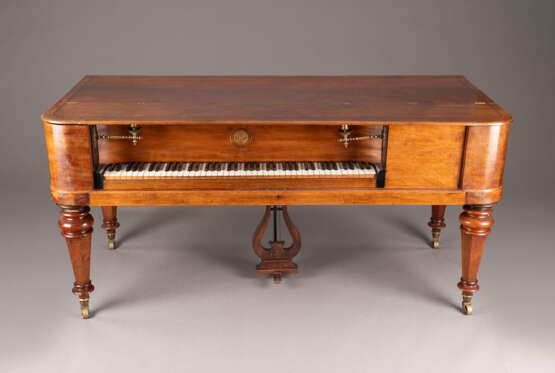ID 1015077
Lot 3149 | HISTORISMUS TAFELKLAVIER VON HORNUNG & MØLLER Kopenhagen,
Estimate value
€ 6 000 – 3 000
HISTORISMUS TAFELKLAVIER VON HORNUNG & MØLLER Kopenhagen, Dänemark, um 1870 Nussbaum, Mahagoni, diverse Hölzer, 82 Tasten aus ebonisierten Holz und Elfenbein-Auflagen (CITES Bescheinigung liegt vor), Massiver Gusseisenrahmen. H. 91,5 cm, B. 190 cm, T. 86 cm. Vorderseitige Plakette 'Hof-Pianofortefabrik KIÖBENHAVN', auf Gusseisen bez. Hornung & Møller, num. 6347. Rechteckkorpus mit abgerundeten Seiten, auf vier achteckigen, abschraubbaren Balusterbeinen, auf Rollen, durchbrochene geschnitzte Resonanzkörperabdeckung, aufklappbar lyraförmige Pedalhalterung, Paar seitliche Messingkerzenhalter.Tonumfang C1 bis a4, Besaitung C1 bis F# einsaitig, umsponnen, G1 bis a4, zweitönig, blanke Eisensaiten. Das Tafelklavier erfreute sich im 19. Jahrhundert großer Beliebtheit. So komponierten beispielsweise Franz Schubert oder Clara und Robert Schumann zahlreiche Werke auf Tafelklavieren. Die Besonderheit bei Tafelklavieren ist die Bauform, da die Saiten quer zu den Tasten verlaufen, sodass diese Anordnung einen rechteckigen Klavierkorpus ermöglicht. Die rechteckige Form erinnert an einen Tisch (Tafel). Conrad Christian Hornung gründete im Jahr 1827 die Klavierhersteller-Firma Hornung in Kopenhagen und 1851 übernahm der Mitarbeiter Hans Petter Møller die Geschäftsleitung. Das Unternehmen wurde seit 1843 Hoflieferant des dänischen Königshauses. Der Kopenhagener Klavier- und Flügelhersteller Hornung & Møller / Möller war die größte Pianofabrik Dänemarks und bis zur Schließung der Fabrik im Jahr 1972 wurden schätzungsweise 50.000 Instrumente hergestellt. Ein früheres Modell befindet sich im Museum für Kunst und Gewerbe in Hamburg. Kl. Funierschäden, Kratzer, Tastatur min. ber., Stimmung erforderlich, spielbereit, Hammermechanik funktioniert, geschnitzte Körperabdeckung rest.. Literatur: Vgl. Beurmann, "Das Buch vom Klavier: die Sammlung Beurmann im Museum für Kunst und Gewerbe in Hamburg, 2007, S. 160/161. Provenienz: Niederrheinische Privatsammlung.
| Auction house category: | Musical instruments |
|---|
| Auction house category: | Musical instruments |
|---|
| Address of auction |
Hargesheimer Kunstauktionen Düsseldorf Friedrich-Ebert-Strasse 11+12 40210 Düsseldorf Germany | ||||||||||||||
|---|---|---|---|---|---|---|---|---|---|---|---|---|---|---|---|
| Preview |
| ||||||||||||||
| Phone | +49 (0) 2113020010 | ||||||||||||||
| Fax | +49 (0) 21130200119 | ||||||||||||||
| Buyer Premium | 28.56% | ||||||||||||||
| Conditions of purchase | Conditions of purchase | ||||||||||||||
| Shipping |
Postal service pickup by yourself | ||||||||||||||
| Payment methods |
Wire Transfer | ||||||||||||||
| Business hours | Business hours
|



